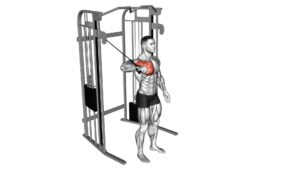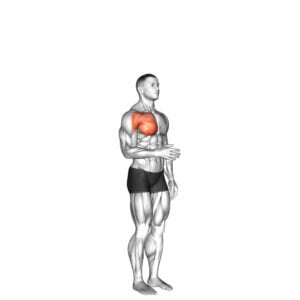Seated Shoulder 90 Degrees Internal Rotation – Video Exercise Guide & Tips

Are you looking to improve your shoulder mobility and strength? Look no further than the seated shoulder 90 degrees internal rotation exercise.
Watch This Exercise Video
In this video exercise guide, we'll show you the proper form and setup, equipment needed, and a step-by-step guide on how to perform this exercise correctly. Avoid common mistakes, maximize the benefits, and take your shoulder fitness to the next level.
Let's get started!
Key Takeaways
- Proper form and setup are essential for performing the seated shoulder 90 degrees internal rotation exercise effectively.
- The equipment needed for this exercise includes a sturdy chair or bench, a dumbbell or resistance band, and a stable chair that does not wobble.
- If dumbbells or resistance bands are not available, alternative exercises using household items or bodyweight can be done to achieve similar benefits.
- Common mistakes to avoid include using too much weight or resistance, improper positioning of the shoulder and elbow, rushing through the exercise, and not maintaining proper form and control.
Proper Form and Setup
Start by positioning yourself in a seated position with your back straight and feet planted firmly on the ground. This will provide a stable foundation for performing the seated shoulder 90 degrees internal rotation exercise. Proper form and setup are crucial for maximizing shoulder mobility and muscle activation during this exercise.
To begin, sit on a chair or bench with your back against the backrest. Make sure your hips are positioned at the edge of the seat to allow for full range of motion. Keep your feet shoulder-width apart and firmly planted on the ground throughout the exercise.
Next, extend your arms straight out in front of you at shoulder height. Your palms should face downwards, with your thumbs pointing towards each other. This starting position will help target the internal rotators of your shoulders.
Maintain a slight bend in your elbows and engage your core for stability. Slowly rotate your arms internally, bringing your hands towards your body while keeping your elbows at shoulder height. Pause for a moment, then return to the starting position with control.
Remember to perform this exercise in a controlled manner, focusing on the muscles being targeted. By maintaining proper form and setup, you can improve shoulder mobility and activate the necessary muscles for optimal results.
Equipment Needed
To perform the seated shoulder 90 degrees internal rotation exercise, you'll need the following equipment. First, you'll need a sturdy chair or bench that allows you to sit comfortably with your feet flat on the floor. Make sure the chair is stable and won't wobble during the exercise. Additionally, you'll need a dumbbell or a resistance band. The weight of the dumbbell should be challenging but manageable for you. If you're using a resistance band, choose one with enough tension to provide resistance throughout the movement.
Having the right equipment is crucial for performing seated shoulder exercises effectively and safely. The benefits of seated shoulder exercises include improving shoulder stability, increasing range of motion, and strengthening the muscles in the shoulder joint. These exercises can also help alleviate shoulder pain and prevent injuries.
If you don't have access to dumbbells or resistance bands, there are alternative exercises you can do for shoulder rotation. These include using household items like water bottles or cans as makeshift weights, or performing bodyweight exercises like wall push-ups or plank shoulder taps. These alternatives can provide a similar range of motion and muscle activation as the seated shoulder 90 degrees internal rotation exercise.
With the necessary equipment in place, you're now ready to move on to the step-by-step exercise guide.
Step-By-Step Exercise Guide
To begin the step-by-step exercise guide for seated shoulder 90 degrees internal rotation, position yourself on a sturdy chair or bench with your feet flat on the floor. This exercise is great for injury prevention and muscle activation in the shoulders.
- Sit up straight and engage your core muscles to maintain good posture throughout the exercise.
- Hold a dumbbell or a resistance band in your hand, with your elbow bent to 90 degrees and your upper arm parallel to the floor.
- Keeping your elbow against your side, slowly rotate your forearm inward, bringing the dumbbell or resistance band across your body.
- Pause for a moment at the end of the movement, feeling the contraction in your shoulder muscles, and then slowly return to the starting position.
Remember to breathe steadily and avoid any jerking or sudden movements. Focus on controlled and smooth motions to maximize the effectiveness of the exercise.
Start with a weight or resistance band that challenges you but still allows you to maintain proper form. As you become more comfortable with the exercise, you can gradually increase the weight or resistance to continue challenging your muscles.
Common Mistakes to Avoid
While performing the seated shoulder 90 degrees internal rotation exercise, it's important to be aware of common mistakes to avoid. By understanding these errors, you can ensure that you're performing the exercise correctly and maximizing its benefits.
One common mistake is using too much weight or resistance. It's crucial to start with a weight that's manageable and gradually increase it as your strength improves. This will prevent strain or injury to the shoulder joint.
Another mistake to avoid is improper positioning of the shoulder. Make sure your shoulder is stabilized throughout the movement and that your elbow is at a 90-degree angle. This will target the correct muscles and prevent unnecessary stress.
Lastly, rushing through the exercise or using momentum is a common mistake. Slow and controlled movements are essential for proper shoulder rotation and to effectively engage the muscles.
Tips for Maximizing Benefits
To maximize the benefits of the seated shoulder 90 degrees internal rotation exercise, focus on maintaining proper form and gradually increasing the weight or resistance. By following these tips, you can't only enhance the effectiveness of the exercise but also prevent injuries.
Here are four key tips for maximizing the benefits of the seated shoulder 90 degrees internal rotation exercise:
- Start with light weights: When beginning this exercise, it's important to start with lighter weights or resistance. This allows your muscles to adapt and gradually increase in strength without risking injury.
- Maintain proper form: Throughout the exercise, ensure that your back is straight, shoulders are relaxed, and elbows are at a 90-degree angle. This helps target the correct muscles and prevents unnecessary strain on other areas of your body.
- Control the movement: Focus on controlling the movement throughout the exercise. Avoid using momentum or jerking motions, as this can lead to injury. Instead, move slowly and deliberately, feeling the muscles in your shoulder working.
- Listen to your body: Pay attention to how your body feels during the exercise. If you experience any pain or discomfort, stop immediately and consult a healthcare professional. It's important to prioritize your safety and prevent any potential injuries.
Frequently Asked Questions
How Often Should I Perform the Seated Shoulder 90 Degrees Internal Rotation Exercise?
To improve shoulder mobility, it's important to perform the seated shoulder 90 degrees internal rotation exercise regularly. The exercise frequency depends on your specific goals and fitness level. However, a general recommendation is to perform this exercise 2-3 times per week.
Consistency is key to seeing progress and preventing injury. Remember to listen to your body and adjust the frequency as needed.
Always consult with a healthcare professional before starting any new exercise routine.
Can I Modify This Exercise if I Have a Shoulder Injury or Limited Range of Motion?
If you have a shoulder injury or limited range of motion, you may need to modify the seated shoulder 90 degrees internal rotation exercise.
It's important to prioritize your safety and avoid aggravating your condition. Consider consulting with a healthcare professional or physical therapist who can provide specific modifications tailored to your needs.
They can guide you on alternative exercises or adjustments to the existing exercise to ensure you can still engage in safe and effective shoulder rehabilitation.
Are There Any Alternative Exercises I Can Do to Target the Same Muscle Groups?
If you're looking for alternative exercises that target the same muscle groups, there are a few options you can try.
One option is the standing shoulder internal rotation exercise, which involves using a resistance band or cable machine.
Another option is the dumbbell internal rotation exercise, where you hold a dumbbell and rotate your shoulder inward.
These exercises can help you work the same muscles as the seated shoulder 90 degrees internal rotation exercise, but in a different way.
Is It Normal to Feel Discomfort or a Burning Sensation During This Exercise?
Managing discomfort during the exercise is crucial to prevent injury. Focus on maintaining proper form and technique throughout.
It's normal to feel some discomfort or a burning sensation, especially if you're new to this exercise. However, if the pain becomes sharp or excessive, it's important to stop and consult a professional.
Make sure to start with lighter weights and gradually increase as you become more comfortable and confident in your abilities.
How Long Should I Hold the End Position of the Exercise for Maximum Benefit?
To get the maximum benefit from the exercise, hold the end position for a reasonable amount of time. The length of time you hold the position can vary depending on your fitness level and comfort.
It's important to find a balance between challenging yourself and avoiding any pain or discomfort. By holding the exercise position, you can further strengthen and improve your shoulder mobility.
Remember to listen to your body and adjust accordingly for a safe and effective workout.
Conclusion
In conclusion, performing seated shoulder 90 degrees internal rotation exercise correctly is crucial for maximizing its benefits.
By maintaining proper form and avoiding common mistakes, you can effectively target and strengthen your shoulder muscles.
Remember to use the necessary equipment and follow the step-by-step guide to ensure a safe and effective workout.
Incorporating this exercise into your routine can help improve your shoulder mobility and overall upper body strength.

Author
Years ago, the spark of my life’s passion ignited in my mind the moment I stepped into the local gym for the first time. The inaugural bead of perspiration, the initial endeavor, the very first surge of endorphins, and a sense of pride that washed over me post-workout marked the beginning of my deep-seated interest in strength sports, fitness, and sports nutrition. This very curiosity blossomed rapidly into a profound fascination, propelling me to earn a Master’s degree in Physical Education from the Academy of Physical Education in Krakow, followed by a Sports Manager diploma from the Jagiellonian University. My journey of growth led me to gain more specialized qualifications, such as being a certified personal trainer with a focus on sports dietetics, a lifeguard, and an instructor for wellness and corrective gymnastics. Theoretical knowledge paired seamlessly with practical experience, reinforcing my belief that the transformation of individuals under my guidance was also a reflection of my personal growth. This belief holds true even today. Each day, I strive to push the boundaries and explore new realms. These realms gently elevate me to greater heights. The unique combination of passion for my field and the continuous quest for growth fuels my drive to break new ground.







